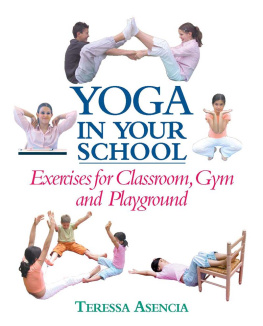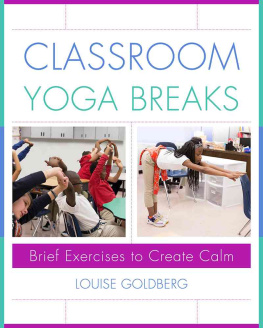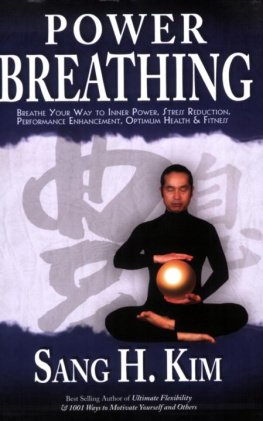

With gratitude to my Yoga teachers,
Baba Muktananda and Gurumayi Chidvilasananda
Text copyright 2006-2011 Teressa Asencia/Photographs Wes Gerrish
All rights reserved. No portion of this eBook may be copied or redistributed without the express written permission of the author.
www.yogainyourschool.com
Princeton Book Company Publishers
614 Route 130, Hightstown NJ 08520
www.princetonbookcompany.com
Although the author has made every effort to ensure that the poses presented in this book are safe, please practice only the poses that are comfortable for you and your students. The author, publisher, participants and distributors of this book disclaim any liability in connection with the exercises and advice herein.
Library of Congress Cataloging-in-Publication Data
Asencia,Teressa.
Yoga in your school: excercises for classroom, gym, and playground / Teressa Asencia.
p. cm.
Includes bibliographical references.
1. Hatha yoga for children. 2. Exercise for children. I. Title.
RJ133.7.A84 2006
613.7046083-dc22
2006046004
Cover and interior design by John McMenamin
6 5 4 3 2 1
To Celeste and Orson

The secret of a better world lives in the hearts of our children.
CONTENTS
AUTHORS NOTE
Perhaps the seeds for this book were planted inside me at an early age. At age four when I did not want to leave the playground to come inside for lunch when called, I was put in a room alone and then expelled from nursery school. When it was time to enter first grade, my mother carried me kicking and screaming to the door of the school. As I sat inside my stuffy classroom for the next few years, my body often felt tense and yearned to move as I eagerly counted the long minutes before each short recess.
One of my first memories of effective learning took place when my eighth grade teacher gave us an extra-curricular course on listening skills. Another striking experience of effective learning took place at the Writers Workshop at the University of Iowa when a well-known poet taught my class how good writing is perfectly simple and always written from personal experience.
May the simple style of this book be an ode to his mantra, The fewer the words, the more the meaning. May my thirty years of personal experience with the simple, powerful and delicious techniques presented in this book, jump off the pages and inspire teachers and students to share a more enjoyable, effective learning process.
INTRODUCTION
Take a Yoga Break
Simplicity is the most difficult thing to secure in this world. It is the last limit of experience and the last effort of genius.
George Sand
What is Yoga?
Yoga is an ancient science that originated in India 5000 years ago. In simple terms, Yoga teaches the art of living a healthy and happy life. The Sanskrit word Yoga means yoke or union. The essence of Yoga is the experience of the unity inherent in all creation.
The form of Yoga that has recently become popular in the Western world is Hatha Yoga, which consists of a series of comprehensive physical exercises and breathing techniques designed to rejuvenate every part of the body and calm the mind. While strengthening both body and mind, these exercises also tone the muscles, expand breathing capacity, soothe the nervous system and energize and harmonize body and mind. Some exercises also enhance concentration, inspire moral courage, and teach qualities such as patience and insight.
After thirty years of study, research and teaching in Yoga, the author has extracted the essential elements and adapted these techniques into simple exercises that can easily be taught in the modern classroom to enhance the learning process.

The techniques presented in Yoga in Your School are ideal for use in regular classrooms, playgrounds and physical education classes in schools. Many of the exercises in this book may also be used in camps, community and recreation centers, and also in dance and yoga classes for children.
ONE
Why Yoga in Your School?
I am convinced that work is love in action. If we thought like this, we would do great things.
Jean Pinchert Dixon
Teaching is one of the most essential professions and also one of the most demanding. This book is designed to give teachers simple techniques to enhance their own energy as they inspire students to enjoy a more efficient and joyous learning process.
Being a successful teacher requires great energy, inner strength, resourcefulness and creativity. As with any classroom instruction, it is important for the teacher to provide the model. If teachers have inner strength and harmony, children will feel it and imbibe it. Through sharing the simple techniques presented in this book, teachers may inspire students to enhance both physical and mental strength and develop habits that will enable them to take responsibility for their own well-being for the rest of their lives.
Children love to move. In the traditional classroom, children are very sedentary. When they sit still too long, they feel tense and it is more difficult for them to learn. With a few movement and breathing exercises daily, teachers may easily release this tension and inspire students to tap into their innate wisdom, creativity and potential.
Most of the exercises may be practiced in a small space such as a regular classroom. Many of the breathing exercises and simple movement exercises may be done while sitting at a desk or standing beside a desk. Other exercises are ideal for larger spaces such as the gymnasium, playground or sports field. Teachers are encouraged to adapt these exercises for their particular circumstances.
Within the next five to ten years, Yoga in school will be the norm.
Mariam Gates, Child Magazine, September 2003
The Benefits ofYoga in Your School
Our modern world is highly advanced in technology, yet we have lost many of the ancient keys to the knowledge of the art of living. Recently, Yoga has become increasingly popular worldwide and an estimated 35 million people in North America now take a Yoga class once a week.
Yoga is currently practiced in many educational institutions worldwide. In France, South America, India, Italy and several other European countries, Yoga has been taught in schools for more than twenty-five years. Many schools in North America have already trained teachers to include Yoga as a regular part of the classroom day. It is also becoming more common as a regular part of the physical education curriculum where it offers a non-competitive alternative to competitive sports.
It is possible to build body strength and flexibility through many forms of physical exercise. The unique aspect of Yoga is that it builds both inner and outer strength, endurance and flexibility. In addition to enhancing physical and mental well-being,Yoga teaches students to concentrate, releases tension and develops inner qualities such as patience and insight. With regular practice, students learn to develop better self-control, inner confidence and focus. Regular Yoga practice unifies the two sides of the brain, allowing information and knowledge to enter the brain at deeper levels. Practicing the exercises together enhances the relationship between teacher and students, enabling them to work together productively and enjoy the learning process.
Next page

![Dorian Ritter (2023) - The Strength Training Workouts Bible for Seniors 60+: [7 in 1] The Most Complete Guide of 200+ Simple Exercises that Elderly of Any Level Can Do Step by Step at Home](/uploads/posts/book/451362/thumbs/dorian-ritter-2023-the-strength-training.jpg)









